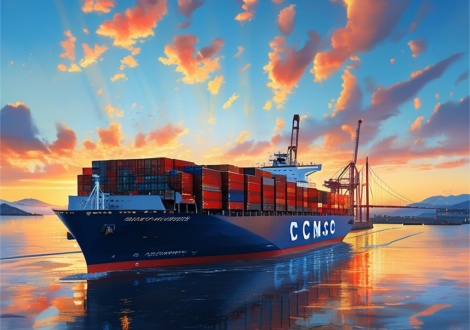- By TOP CHINA FREIGHT
- August 12, 2025
- Shipping
Shipping from China to Thailand has long been supported by geographical proximity and complementary economies. Whether you are importing raw materials, consumer goods, or specialized equipment, it is a critical part of your supply chain.This guide will walk you through every step of the process—covering transportation methods, costs, transit times, customs requirements, and practical tips—so you can plan your shipments efficiently and avoid unnecessary delays.

1.Key Industries Importing from China to Thailand
Chinese fabrics, clothing, and footwear supply Thailand’s retail, wholesale, and export-oriented garment industries.
Imports such as steel, aluminum, tiles, and fittings from China support Thailand’s growing infrastructure and real estate sectors.
Solar panels, wind turbines, and related components are increasingly imported from China to support Thailand’s shift toward sustainable energy.
Affordable home furnishings, kitchenware, and décor items from China are popular among Thai retailers and e-commerce sellers.
Thailand imports large volumes of smartphones, computers, televisions, and household electrical devices from China, supplying both consumer markets and industrial needs.
With Thailand’s automotive sector being one of the largest in Southeast Asia, Chinese-made machinery, spare parts, and assembly components are essential for local manufacturing and maintenance.
2.Main Shipping Methods from China to Thailand
Shipping from Thailand to France can be done through several methods, each with its advantages and limitations. The most common shipping methods are sea freight, air freight, and rail freight.

Sea Freight
Sea freight is the most popular method for moving large, heavy, or bulky goods between China and Thailand. It offers lower costs per cubic meter compared to air or land transport, though transit times are longer.
Key Chinese Ports:
- Shanghai
- Shenzhen
- Ningbo
- Qingdao
- Guangzhou
- Xiamen
- Hong Kong
Main Thai Ports:
- Laem Chabang Port – Thailand’s largest deep-sea port, capable of handling large container ships.
- Bangkok Port (Klong Toey) – Suitable for smaller vessels and closer to central Bangkok.
Transit Time:
7–15 days (port-to-port), depending on the route and vessel schedule.
Best for:
Shipments over 500 kg or more than 3 cubic meters in volume.

Air Freight
Air freight is the fastest way to move goods from China to Thailand. This option is ideal for urgent deliveries, high-value items, or perishable goods.
Major Origin Airports in China:
- Beijing Capital International Airport (PEK)
- Shanghai Pudong International Airport (PVG)
- Guangzhou Baiyun International Airport (CAN)
- Shenzhen Bao’an International Airport (SZX)
Destination Airports in Thailand:
- Suvarnabhumi Airport (BKK) – Main international hub in Bangkok.
- Don Mueang International Airport (DMK) – Mostly low-cost carriers and cargo.
- Chiang Mai International Airport (CNX) – Northern Thailand shipments.
Transit Time:
1–3 days for direct flights; 3–5 days for consolidated air freight.
Best for:
Shipments under 300 kg that require fast delivery.

Rail Freight
Rail freight between China and Thailand is developing rapidly through the China–Laos–Thailand Railway, part of the Belt and Road Initiative. Although not yet as fast as air freight or as cheap as sea freight for very large volumes, rail offers a good balance between cost and speed.
Transit Time:
5–8 days (station-to-station).
Best for:
Medium-volume shipments requiring more reliability than sea but at lower cost than air.
3.Shipping Options: FCL vs. LCL
FCL (Full Container Load):
- You rent the entire container.
- Best for large shipments that can fill 20ft or 40ft containers.
- Lower cost per unit when fully loaded.
LCL (Less than Container Load):
- You share container space with other shippers.
- Suitable for smaller shipments.
- Slightly longer handling times due to consolidation.
4.Shipping Costs from China to Thailand
The cost depends on:
- Mode of transport (sea, air, road, rail)
- Cargo weight and volume
- Origin and destination
- Type of goods (general cargo, dangerous goods, temperature-controlled goods)
- Incoterms (e.g., EXW, FOB, CIF)
General cost guide (2025 estimates):
- Sea Freight LCL: USD 30–60 per cubic meter.
- Sea Freight FCL: USD 600–1,200 for a 20ft container; USD 1,000–1,800 for a 40ft container.
- Air Freight: USD 3–6 per kg.
- Rail Freight: USD 1–2 per kg for consolidated shipments.
5.Transit Time Summary
| Mode | Transit Time (Approx.) |
|---|---|
| Sea Freight | 7–15 days |
| Air Freight | 1–5 days |
| Rail Freight | 5–8 days |
6.Import Documents for Thailand
| Document | Purpose |
|---|---|
| Commercial Invoice | Lists product details, quantity, price, and payment terms for customs valuation. |
| Packing List | Details packaging, dimensions, and weight to assist in cargo handling and customs checks. |
| Bill of Lading / Air Waybill | Acts as a shipment receipt and contract of carriage between shipper and carrier. |
| Import License (if applicable) | Required for controlled goods such as chemicals, pharmaceuticals, or certain electronics. |
| Certificate of Origin | Proves product origin, enabling preferential tariffs under the ASEAN–China Free Trade Agreement. |
7.Duties and Taxes
| Item | Details |
|---|---|
| Import Duty | Varies by product category; calculated based on the HS code. |
| Value-Added Tax (VAT) | 7% of the CIF value (Cost + Insurance + Freight). |
| Preferential Tariffs | Goods qualifying under ASEAN trade agreements may enjoy reduced or zero import duty. |
8.Tips for a Smooth Shipment
Avoid peak seasons like Chinese New Year or Thailand’s Songkran Festival.
Prevent customs delays and incorrect tax assessments.
Protect against damage, loss, or delays.
Make sure goods are securely packed for long-distance travel.
Define responsibilities clearly with your supplier.
9.Step by Step
Step 1: Choose Your Shipping Method
Decide whether to ship by sea, air, or rail based on your cargo size, budget, and delivery urgency.
Step 2: Find a Reliable Freight Forwarder
Partner with a freight forwarder experienced in China–Thailand shipments. They will assist with booking space, documentation, and customs clearance.
Step 3: Prepare Shipping Documents
Gather necessary documents such as commercial invoice, packing list, export license (if needed), and certificate of origin. Your forwarder can help ensure accuracy.
Step 4: Book Your Shipment
Once documents are ready and cargo is packed, your freight forwarder books space on the chosen vessel, flight, or train.
Step 5: Export Customs Clearance in China
The goods must clear Chinese customs. Your forwarder or supplier will submit documents and pay any export duties or taxes if applicable.
Step 6: Cargo Transportation
Your cargo is transported to the port or airport for loading. For sea freight, containers are loaded onto vessels; for air freight, cargo is consolidated in air cargo terminals.
Step 7: International Transit
Cargo moves from China to Thailand according to the chosen mode’s transit time.
Step 8: Import Customs Clearance in Thailand
Thai customs authorities inspect the shipment and assess duties and taxes. Required documents are submitted to facilitate clearance.
Step 9: Delivery to Final Destination
After customs clearance, your freight forwarder arranges delivery to your warehouse or specified location in Thailand.
Final Thoughts
Shipping from China to Thailand is a vital trade corridor with multiple transport options tailored to different cargo types, budgets, and delivery timelines. Whether you choose sea freight for cost-effective bulk shipments, air freight for speed, or rail for a balanced approach, understanding the process is key to successful logistics management.By preparing the correct documents, working with a trusted freight forwarder, and staying aware of customs regulations and infrastructure developments, you can optimize your supply chain and avoid costly delays.
Ask for a quote
Are you ready shipping from China to Thailand?
Contact TJ China Shipping Forwarder for a fast, accurate, and competitive shipping quote.
FAQs
Q1:What is the fastest shipping method from China to Thailand?
Air freight is the fastest, with delivery typically within 1–5 days, ideal for urgent and high-value shipments.
Q2:How long does sea freight from China to Thailand usually take?
Sea freight generally takes between 7 to 15 days, depending on the port of origin and destination, as well as vessel schedules.
Q3:Can I ship small parcels via sea freight?
While possible, sea freight is most economical for large or bulk shipments. Small parcels are better shipped by air or consolidated LCL sea freight.
Q4:What documents are required for importing goods into Thailand?
Essential documents include a commercial invoice, packing list, bill of lading or air waybill, import license (if applicable), and certificate of origin.
Q5:Are there any import taxes when shipping from China to Thailand?
Yes, import duty rates vary by product type, and a 7% VAT applies based on the CIF value. Preferential tariffs may apply under ASEAN trade agreements.
